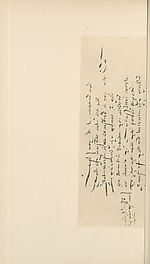Download files
Complete book:
Individual page:
Thumbnail gallery: Grid view | List view

NOTES
TO
THE CHERRIE AND THE SLAE.
§ 1. Allusions to Classical Mythology. — In the annotations
appended to Dr Cranstoun’s edition of Montgomerie’s poems, the
various references to legendary story found in ‘The Cherrie and the
Slae’ are already traced to their classical sources. Allusions of this
kind, it ought, however, to be remembered, form a conventional feature
of the class of poem to which Montgomerie’s allegory belongs, and are
not to be taken as indicating a close acquaintance on the poet’s part
with the classical writers who first gave these legends currency in
Europe. His ‘mythological lore,’ which Dr Cranstoun inclines to
regard as too ostentatiously paraded, is, as a matter of fact, drawn
from a common stock, open and familiar to the romantic allegorists,
both in England and Scotland, during the fifteenth and sixteenth
centuries. Montgomery, out of his own knowledge of the classics,
makes no fresh contribution to the ordinary round of these allusions.
With Chaucer, Gower, and Lydgate to draw upon, and the works of
their Scottish imitators, he had no occasion indeed to go farther
afield. The following notes, supplementing Dr Cranstoun’s, make
this clear :1—
7-14. Legend of Progne and Philomela. Told at length by Chaucer
in the ‘ Legend of Good Women’ (No. vii.). See also ‘Troilus,’ II.,
64 If.; Lydgate, ‘Temple of Glas’ (11. 97-99)—
‘ ‘ Ther sawe I writen eke lie hole tale
Hov Philomene into ny3tyngale
Iturned was, and Progne vnto a swalow.”
See also his ‘Falls of Princes’ (f. 9«.); ‘Reson and Sensuallyte’
1 Unless when otherwise stated, the notes refer to the expanded version of the
poem published in 16x5, represented in this volume by Wreittoun’s print of 1636.
Y
TO
THE CHERRIE AND THE SLAE.
§ 1. Allusions to Classical Mythology. — In the annotations
appended to Dr Cranstoun’s edition of Montgomerie’s poems, the
various references to legendary story found in ‘The Cherrie and the
Slae’ are already traced to their classical sources. Allusions of this
kind, it ought, however, to be remembered, form a conventional feature
of the class of poem to which Montgomerie’s allegory belongs, and are
not to be taken as indicating a close acquaintance on the poet’s part
with the classical writers who first gave these legends currency in
Europe. His ‘mythological lore,’ which Dr Cranstoun inclines to
regard as too ostentatiously paraded, is, as a matter of fact, drawn
from a common stock, open and familiar to the romantic allegorists,
both in England and Scotland, during the fifteenth and sixteenth
centuries. Montgomery, out of his own knowledge of the classics,
makes no fresh contribution to the ordinary round of these allusions.
With Chaucer, Gower, and Lydgate to draw upon, and the works of
their Scottish imitators, he had no occasion indeed to go farther
afield. The following notes, supplementing Dr Cranstoun’s, make
this clear :1—
7-14. Legend of Progne and Philomela. Told at length by Chaucer
in the ‘ Legend of Good Women’ (No. vii.). See also ‘Troilus,’ II.,
64 If.; Lydgate, ‘Temple of Glas’ (11. 97-99)—
‘ ‘ Ther sawe I writen eke lie hole tale
Hov Philomene into ny3tyngale
Iturned was, and Progne vnto a swalow.”
See also his ‘Falls of Princes’ (f. 9«.); ‘Reson and Sensuallyte’
1 Unless when otherwise stated, the notes refer to the expanded version of the
poem published in 16x5, represented in this volume by Wreittoun’s print of 1636.
Y
Set display mode to: Large image | Zoom image | Transcription
Images and transcriptions on this page, including medium image downloads, may be used under the Creative Commons Attribution 4.0 International Licence unless otherwise stated. ![]()
| Publications by Scottish clubs > Scottish Text Society publications > Old series > Poems of Alexander Montgomerie > (420) |
|---|
| Permanent URL | https://digital.nls.uk/110175089 |
|---|
| Description | A collection of over 100 Scottish texts dating from around 1400 to 1700. Most titles are in Scots, and include editions of poetry, drama, and prose by major Scottish writers such as John Barbour, William Dunbar, Gavin Douglas, and George Buchanan. Edited by a key scholarly publisher of Scotland's literary history, and published from the late 19th century onwards by the Scottish Text Society. Available here are STS series 1-3. |
|---|

